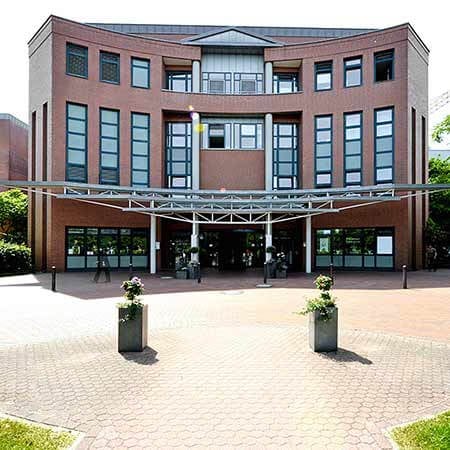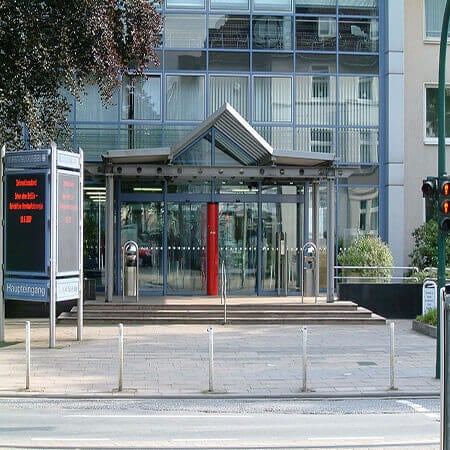Tricuspid valve stenosis is the rarest valvular heart disease. With this disease, the area of the opening between the right atrium and the right ventricle decreases. If its diameter is less than 1 square centimeter, the form of the defect is considered severe, so surgical correction is required. Although tricuspid valve stenosis may be asymptomatic for a long time, the prognosis in the event of the development of this disease is poor, as it leads to right ventricular heart failure.
Content
- Causes
- Symptoms
- Diagnostics
- Treatment principles
- Conservative therapy
- Surgical treatment
- Why is it worth undergoing treatment in Germany
- Treatment in Germany with Booking Health
Causes
By origin, tricuspid valve stenosis can be:
Congenital stenosis is very rare. This is mainly a consequence of Ebstein's anomaly. In this disease, the tricuspid valve does not develop correctly. Its position is below its usual location, and the valve is attached to the walls of the right ventricle. Stenosis is usually associated with heart valve failure.
In most cases, stenosis is acquired. This is mainly a consequence of previously suffered endocarditis. In patients with this pathology, tricuspid stenosis is almost always combined with other heart valve defects, for example, aortic stenosis or mitral insufficiency.
Other, less likely causes:
- Infective endocarditis – inflammation of the inner lining of the heart, usually caused by bacteria or fungi.
- Fibroelastosis – endocardial thickening.
- Systemic lupus erythematosus.
- Neuroendocrine tumors that produce serotonin (a carcinoid that usually appears in the intestines).
- Limited constrictive pericarditis.
Due to the causes listed, the tricuspid valve leaflets are directly damaged. There are also diseases that do not damage the valve itself, but cause a narrowing of its opening. These are primary or metastatic tumors in the right atrium. The main primary tumor is myxoma. It is possible for metastases to invade through the inferior vena cava system in patients with neoplasms of the abdominal cavity and lower extremities.
Tricuspid valve stenosis can be not only organic, but also functional. This means that the valve is not damaged, but the mobility of its leaflets is temporarily limited. This most often occurs due to myocarditis, which is an inflammatory heart disease. The myocardium becomes inflamed, thickened, and the valve flaps cannot function normally. In most cases, inflammation of the heart muscle is of viral origin. The treatment of the underlying disease contributes to the restoration of the function of the valve, and its replacement is not required.
Symptoms
In most cases of tricuspid stenosis, there are no or minimal symptoms. With the development of severe stenosis, the following complaints are possible:
- Impaired work of the heart.
- Pain and heaviness in the right hypochondrium with congestion in the liver.
- Increased size of the abdomen if fluid accumulates in it (ascites).
- Leg swelling.
- General weakness, fatigue, poor exercise tolerance, shortness of breath, cough.
The jugular veins pulsate strongly, so neck discomfort is possible. When cardiac output decreases, the skin becomes cold.
Diagnostics
The main method for diagnosing the disease is echocardiography. With ultrasound, the doctor can see the following:
- Reduced opening of the heart valves.
- Their thickening and deposits of calcium salts.
- Shortened chords.
- Decreased area of the tricuspid valve.
- Dilatation (enlargement) of the right atrium.
Concomitant mitral defects are often diagnosed as well. But without them, the right ventricle does not increase in size.
The doctor assesses the gradient (drop) of diastolic (during relaxation of the heart muscle) pressure to determine the severity of the heart disease.
Additional diagnostic examinations include:
- ECG.
- Transesophageal echocardiography (if indicated).
- General clinical tests and coagulogram.
Treatment principles
The goal of treatment is to relieve symptoms, improve quality of life, and prevent decompensation of heart disease and pathological changes in the myocardium. Early correction of the defect is usually not performed. If possible, doctors use only conservative treatment.
However, it should be borne in mind that tricuspid stenosis is very rarely found as an isolated defect. In most cases, a person simultaneously suffers not only from tricuspid valve stenosis, but also from its insufficiency. The patients with tricuspid stenosis are usually diagnosed with other heart valve defects concurrently. This is due to the fact that the main cause of the disease is rheumatism, and this pathology affects not one, but several valves at once. Mitral valve defects are mostly diagnosed in patients with tricuspid stenosis.
Conservative therapy
The main problem in patients with tricuspid valve stenosis is right ventricular heart failure. Therefore, conservative treatment is aimed at relieving its symptoms.
Patients receive diuretics because their legs are swollen and fluid accumulates in the abdomen. Usually these are loop diuretics, less often potassium-sparing diuretics. Additionally, ACE inhibitors and potassium preparations can be used.
Surgical treatment
Conservative therapy only improves the quality of a person's life, but cannot eliminate heart disease. Therefore, the basis of treatment is surgery. The surgical procedure can be performed in the following cases:
- Severe symptomatic stenosis.
- Severe stenosis and other heart defects that require surgical correction. In this case, the doctor can also eliminate tricuspid stenosis during an operation to eliminate valve defects in the left half of the heart.
The surgical procedures used for tricuspid valve stenosis are divided into two types: plastic (reconstruction) of the valve or its prosthetic repair. Reconstruction is more preferred. It provides better and more reliable outcomes. This is due to the fact that biological prostheses, which have a limited service life, are mainly used for tricuspid valve replacement surgery. With this treatment option, it is highly likely that the patient will need repeated surgery in the future to replace a worn artificial valve. Therefore, replacement surgery is resorted to only in extreme cases, when the tricuspid valve cannot be repaired.
Valve reconstruction for Ebstein's anomaly
About 1 in 20 thousand children are born with Ebstein's anomaly – congenital tricuspid valve stenosis. This disease accounts for 1% of congenital heart defects. Ebstein's anomaly is usually combined with Wolff-Parkinson-White syndrome.
Half of the children undergo valve correction rather than valve replacement. There are several types of surgical procedures. The most widespread are two types of interventions that have a low mortality rate, as well as provide good immediate and long-term results. Plastic repair options:
Danielson plastic repair. During the operation, a "mono-leaf" valve is created. The main locking function is performed by the anr leaflet. The level of their attachment remains unchanged.
Cone-shaped reconstruction. The operation was developed recently – in 2007. It provides anatomical reconstruction, that is, as close as possible to the natural structure of the tricuspid valve. It is not only restored, but also moved to the correct position. During the operation, it is often necessary to strengthen the annulus fibrosus in order to avoid the development of valve insufficiency in the long-term postoperative period due to the possible detachment of the leaflets.
Reconstruction for acquired stenosis
Commissurotomy is the main surgical procedure for acquired tricuspid valve stenosis.
This is an open-heart operation. The doctor makes a large incision in the chest, connects the heart-lung machine. To protect the myocardium, special solutions are injected into the aortic root. At the same time, interventions are performed on other valves, since the tricuspid alone is rarely affected. The doctor most often restores or replaces the mitral valve, less often the aortic valve.
Commissurotomy is an operation to cut the commissures. The doctor divides the tricuspid valve leaflets to improve their mobility. Annuloplasty may be additionally required as well. The procedure involves strengthening of the fibrous ring, to which the leaflets are attached.
Minimally invasive treatment
Balloon valvuloplasty is an option for minimally invasive treatment of tricuspid valve stenosis. No chest incisions are required. The doctor makes an incision in the leg and inserts the catheter. It delivers a balloon to the heart, which is advanced to the area of the right atrioventricular opening and inflated with a contrast medium. The balloon expands and increases the valve lumen.
The prospect of minimally invasive surgery instead of open surgery seems attractive to many patients. Obviously, this approach has many advantages:
- Fewer health risks.
- No need for long hospitalization and rehabilitation.
- Better postoperative tolerance.
- Less blood loss.
- No large scars on the chest.
Nonetheless, in practice, balloon valvuloplasty (balloon commissurotomy) of the tricuspid valve is rarely used. It is less efficient than open reconstruction. To perform this surgical procedure, a number of conditions are required:
- Favorable anatomy of the tricuspid valve for minimally invasive correction.
- Lack of other valvular heart diseases (which is extremely rare) or concomitant defects can also be corrected using an endovascular procedure.
- Presence of tricuspid valve stenosis in the absence of its insufficiency.
Even in these cases, the results of balloon valvuloplasty are worse. The valve area increases to a lesser extent than after open surgery. In addition, some patients develop tricuspid valve insufficiency instead of stenosis, which requires additional treatment. Therefore, balloon commissurotomy in Germany is used mainly in patients with a high surgical risk. In other words, for those for whom open surgery is too risky due to severe concomitant diseases.
Valve replacement
Prosthetic repair is the replacement of the patient's own valve with an artificial endoprosthesis. They can be mechanical and biological. In the vast majority of cases, biological prostheses are implanted in the position of the tricuspid valve. This is due to the fact that blood clots are more likely to form in the right half of the heart in the presence of a mechanical prosthesis. Complications are more common in these patients. In addition, doctors have to resort to more intensive anticoagulant therapy, which "thins" the blood and increases the risk of bleeding.
This is open-heart surgery. The doctor simultaneously performs prosthetic repair not only of the tricuspid, but also of other valves damaged as a result of endocarditis.
Repeated tricuspid valve replacement
Biological prostheses have a limited service life, and this is their main disadvantage. This problem is especially relevant for patients with tricuspid stenosis, since the heart disease is usually not degenerative, but rheumatic in its origin. This means that it can develop at any age and is more commonly found in young patients with high life expectancy. In addition, valve stenosis can be congenital, so children often have to perform tricuspid valve replacement.
Most of these patients will sooner or later require tricuspid valve replacement surgery, as the prosthesis dysfunction develops. Its gradual degeneration occurs.
Repeated open-heart surgery is usually performed for prosthesis replacement. These operations are complex and have higher patient mortality rates. According to estimates by different authors, it ranges from 13 to 37%.
In Germany, doctors use not only open, but also minimally invasive valve-to-valve repeated prosthetics – TVIV (tricuspid valve-in-valve). A new artificial valve is inserted through an incision in the leg and placed over the old one. The size of the prosthesis is selected individually. Doctors use the electronic catalog to select an artificial joint for transcatheter implantation by axial size, diameter, orifice area.
So far, the experience with the procedure is relatively small, so it is recommended only for patients with high surgical risks who are contraindicated for open-heart surgery. It reduces the number of open tricuspid valve surgeries.
Why is it worth undergoing treatment in Germany
German cardiac surgeons are considered to be among the best in the world. They successfully operate on patients of any age, including children and the elderly with concomitant diseases. German cardiac surgery hospitals have state-of-the-art equipment at their disposal. The hospitals use modern types of operations that allow doctors to completely restore hemodynamics in valvular heart disease.
There are several reasons why it is worth undergoing treatment of tricuspid valve stenosis in Germany:
- No over-treatment: for mild stenosis, you will only receive conservative therapy.
- Minimally invasive treatment is possible: some patients undergo balloon commissurotomy through an incision in the leg instead of open-heart surgery, which reduces the risks of surgery and shortens the rehabilitation period.
- Tricuspid valve repair is always preferred over prosthetics, since after reconstruction there is a lower risk that a second operation will be required in the future.
- With prosthetic repair, biological prostheses are implanted to reduce the risk of thrombosis and thromboembolism, and to avoid the need for lifelong anticoagulant therapy, which increases the risk of bleeding.
- To correct Ebstein's anomaly, a cone-shaped reconstruction of the tricuspid valve is used instead of the outdated Carpentier repair, which has a mortality rate of up to 14%.
- During a single heart surgical procedure, the doctor may repair or replace several heart valves at once.
- It is possible to simultaneously correct several heart diseases at once, for example, valvular heart disease and coronary heart disease using coronary artery bypass grafting.
- When the artificial biological tricuspid valve is worn out, repeated replacement surgery can be performed using a minimally invasive technique, through the vessels on the leg, without repeated open-heart surgery.
Treatment in Germany with Booking Health
To undergo treatment in a hospital in Germany, please use the services of Booking Health. On our website, you can find out the cost of treatment in different hospitals, compare prices and book a medical care program at an affordable price. The treatment of tricuspid valve stenosis in Germany will be easier and faster for you, and the cost of treatment will be lower.
Leave a request on our website. Our employee will contact you and advise you about treatment in Germany. Booking Health will take care of the organization of your trip. We will provide the following benefits for you:
- We will select a hospital in Germany, whose doctors specialize in the treatment of tricuspid valve stenosis.
- We will help you overcome the language barrier, establish communication with your attending physician.
- We will reduce the waiting time for the start of the medical care program and book a doctor's appointment on the most suitable dates.
- We will reduce the price. The cost of treatment in German hospitals will decrease due to the lack of additional coefficients for foreign patients.
- We will take care of all organizational issues: documents for entering the country, transfer from the airport, hotel, interpreter, etc.
- We will prepare a program and translate medical documents. You do not have to repeat the previously performed diagnostic procedures.
- We will provide communication with a hospital in Germany after the completion of the program.
- We will organize additional diagnostic examinations and treatment in German hospitals, if necessary.
- We will buy medicines abroad and forward them to your native country.
- We will help you keep in touch with the hospital and the doctor after the completion of the medical care program.
You will receive treatment from the best doctors in the world. We will take care of all organizational issues, and you will only have to focus on restoring your health.
Authors: Dr. Vadim Zhiliuk, Dr. Sergey Pashchenko














